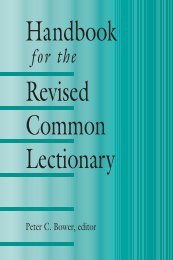000 Allen FMT (i-xxii) - The Presbyterian Leader
000 Allen FMT (i-xxii) - The Presbyterian Leader
000 Allen FMT (i-xxii) - The Presbyterian Leader
You also want an ePaper? Increase the reach of your titles
YUMPU automatically turns print PDFs into web optimized ePapers that Google loves.
Proper 27 [32]/Year B 201<br />
some in the community sought to rid the community of such compromises<br />
with the culture and thereby to invoke God’s blessing on the<br />
restoration of the land.<br />
<strong>The</strong> book of Ruth offers an alternative viewpoint to Ezra-Nehemiah, but<br />
does so in the form of a story. On Proper 26/Year B, we considered the<br />
beginning of the story of the Jewish widow Naomi and the Moabite Ruth.<br />
Ezra 9:1 refers to Moabites (and others) as people from whom Israel should<br />
maintain separation (cf. Neh. 13:1). When the women returned to Israel,<br />
Ruth encountered Boaz while she was gleaning. Boaz was kin to Naomi’s<br />
husband and was responsible for family security. Boaz ensured that Ruth<br />
would receive a generous portion of grain (Ruth 2:1–23), an action that<br />
Naomi interpreted as a means through which God’s hesed was at work (2:20).<br />
Naomi guided Ruth to meet Boaz on the threshing floor (3:5). While<br />
Boaz was sleeping, Ruth lay at his feet and when he awoke asked him to<br />
spread his cloak over her because she was kin, that is, she asked him to<br />
marry her. Boaz, an exemplary Israelite, declared that Ruth was a “worthy<br />
woman,” a woman on a par with Israelite women as a candidate for a<br />
wife. Boaz’s own integrity is verified by the fact that he consulted with a<br />
kin-protector who was more closely related to Ruth than is Boaz (3:1–18).<br />
When the other kin-protector yielded his right to Ruth, Boaz married her.<br />
Ruth gave birth to a child whom the women of the neighborhood named<br />
Obed (4:1–17). <strong>The</strong> narrator concludes with the pointed fact that Ruth<br />
was the grandmother of the great monarch David (4:18–22).<br />
This story challenges the restriction on intermarriage mentioned in the<br />
first part of this comment in two ways. First, it shows a Moabite woman<br />
demonstrating hesed (covenantal loyalty) to the Jewish Naomi. Second, the<br />
exemplary Israelite, Boaz, brings the Moabite into his own household as if<br />
she were an Israelite. Throughout, Ruth manifests qualities of covenantal<br />
behavior. How could the community forbid relationship with the people<br />
of David’s grandparent? An indirect message is that just as God manifested<br />
hesed through the relationship of Naomi and Ruth prior to Ruth’s marriage<br />
to Boaz, so God will continue to manifest that quality through persons and<br />
relationships that are not officially acknowledged by the Jewish leadership.<br />
Jon L. Berquist points out that the mother-in-law and daughter-in-law<br />
are the “relationship of highest significance” for much of the narrative, “a<br />
relationship relatively unidentified within the culture and [that] would<br />
not have been considered to be a family relationship that implied protection.”<br />
As the story moves toward its conclusion, “the family includes Boaz<br />
and Ruth, an absent father and a foreign mother, whose child nursed<br />
at his grandmother’s breast” and who was named by the women of the




